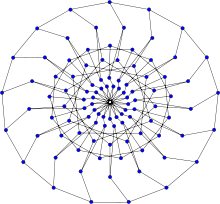Distance-transitive graph

In the mathematical field of graph theory, a distance-transitive graph is a graph such that, given any two vertices v and w at any distance i, and any other two vertices x and y at the same distance, there is an automorphism of the graph that carries v to x and w to y.
A distance transitive graph is vertex transitive and symmetric as well as distance regular.
A distance-transitive graph is interesting partly because it has a large automorphism group. Some interesting finite groups are the automorphism groups of distance-transitive graphs, especially of those whose diameter is 2.
Distance-transitive graphs were first defined in 1971 by Norman L. Biggs and D. H. Smith, who showed that there are only 12 finite trivalent distance-transitive graphs. These are:
| Graph name | Vertex count | Diameter | Girth | Intersection array |
|---|---|---|---|---|
| complete graph K4 | 4 | 1 | 3 | {3;1} |
| complete bipartite graph K3,3 | 6 | 2 | 4 | {3,2;1,3} |
| Petersen graph | 10 | 2 | 5 | {3,2;1,1} |
| Graph of the cube | 8 | 3 | 4 | {3,2,1;1,2,3} |
| Heawood graph | 14 | 3 | 6 | {3,2,2;1,1,3} |
| Pappus graph | 18 | 4 | 6 | {3,2,2,1;1,1,2,3} |
| Coxeter graph | 28 | 4 | 7 | {3,2,2,1;1,1,1,2} |
| Tutte–Coxeter graph | 30 | 4 | 8 | {3,2,2,2;1,1,1,3} |
| Graph of the dodecahedron | 20 | 5 | 5 | {3,2,1,1,1;1,1,1,2,3} |
| Desargues graph | 20 | 5 | 6 | {3,2,2,1,1;1,1,2,2,3} |
| Biggs-Smith graph | 102 | 7 | 9 | {3,2,2,2,1,1,1;1,1,1,1,1,1,3} |
| Foster graph | 90 | 8 | 10 | {3,2,2,2,2,1,1,1;1,1,1,1,2,2,2,3} |
Independently in 1969 a Russian group led by Georgy Adelson-Velsky showed that there exist graphs that are distance-regular but not distance-transitive. The only graph of this type with degree three is the 126-vertex Tutte 12-cage. The smallest distance-regular graph that is not distance-transitive is the Shrikhande graph. Complete lists of distance-transitive graphs are known for some degrees larger than three, but the classification of distance-transitive graphs with arbitrarily large vertex degree remains open.
The simplest asymptotic family of examples of distance-transitive graphs is the Hypercube graphs. Other families are the folded cube graphs and the square rook's graphs. All three of these families have arbitrarily high degree.
References
- Early works
- Adel'son-Vel'skii, G. M.; Veĭsfeĭler, B. Ju.; Leman, A. A.; Faradžev, I. A. (1969), "An example of a graph which has no transitive group of automorphisms", Doklady Akademii Nauk SSSR, 185: 975–976, MR 0244107.
- Biggs, Norman (1971), "Intersection matrices for linear graphs", Combinatorial Mathematics and its Applications (Proc. Conf., Oxford, 1969), London: Academic Press, pp. 15–23, MR 0285421.
- Biggs, Norman (1971), Finite Groups of Automorphisms, London Mathematical Society Lecture Note Series, 6, London & New York: Cambridge University Press, MR 0327563.
- Biggs, N. L.; Smith, D. H. (1971), "On trivalent graphs", Bulletin of the London Mathematical Society, 3 (2): 155–158, doi:10.1112/blms/3.2.155, MR 0286693.
- Smith, D. H. (1971), "Primitive and imprimitive graphs", The Quarterly Journal of Mathematics. Oxford. Second Series, 22 (4): 551–557, doi:10.1093/qmath/22.4.551, MR 0327584.
- Surveys
- Biggs, N. L. (1993), "Distance-Transitive Graphs", Algebraic Graph Theory (2nd ed.), Cambridge University Press, pp. 155–163, chapter 20.
- Van Bon, John (2007), "Finite primitive distance-transitive graphs", European Journal of Combinatorics, 28 (2): 517–532, doi:10.1016/j.ejc.2005.04.014, MR 2287450.
- Brouwer, A. E.; Cohen, A. M.; Neumaier, A. (1989), "Distance-Transitive Graphs", Distance-Regular Graphs, New York: Springer-Verlag, pp. 214–234, chapter 7.
- Cohen, A. M. Cohen (2004), "Distance-transitive graphs", in Beineke, L. W.; Wilson, R. J., Topics in Algebraic Graph Theory, Encyclopedia of Mathematics and its Applications, 102, Cambridge University Press, pp. 222–249.
- Godsil, C.; Royle, G. (2001), "Distance-Transitive Graphs", Algebraic Graph Theory, New York: Springer-Verlag, pp. 66–69, section 4.5.
- Ivanov, A. A. (1992), "Distance-transitive graphs and their classification", in Faradžev, I. A.; Ivanov, A. A.; Klin, M.; et al., The Algebraic Theory of Combinatorial Objects, Math. Appl. (Soviet Series), 84, Dordrecht: Kluwer, pp. 283–378, MR 1321634.